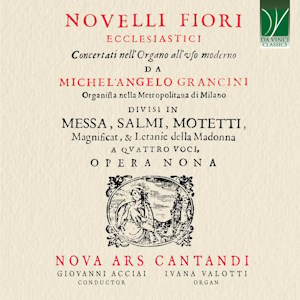
Michel’angelo Grancini (1605-1669)
Novelli Fiori Ecclesiastici
Nova Ars Cantandi/Giovanni Acciai
Ivana Valotti (organ)
rec. 2022, Palatine Basilica of Santa Barbara, Mantua, Italy
No lyrics included
Reviewed as a 16/44 download from Da Vinci Classics
Da Vinci Classics C00895 [68]
The music written in Italy in the first half of the 17th century exerts a great attraction on performers of our time. It seems, though, that the interest is a little one-sided. The music written in Venice and other towns where the modern style was embraced, is given much attention, but what was written and performed elsewhere is probably less often the subject of concerts and recordings. Milan was generally more conservative, if we look at the career of Michel’angelo Grancini. In 1631 he had published his Op. 6, a collection of sacred concertos, some of which with the participation of instruments. In it he expressed his adherence to the stylus modernus, which earned him the criticism of the Milanese ecclesiastical authorities.
Grancini was born in Milan and worked there all his life. At the age of 17 he was already appointed organist at S Maria del Paradiso. Until 1650 he worked in this capacity at several churches. In the latter year he was promoted to the position of maestro di cappella at Milan Cathedral; he remained in this post until his death.
Grancini was a prolific composer: between 1622 and 1669 he published twenty collections of sacred music. Around two hundred pieces have been preserved in manuscript. However, Jerome Roche, in his article on Graccini in New Grove, observes that “the size of his output was not matched by its popularity; very few works appeared in anthologies and his prints appeared in Milan rather than in the main publishing centre of Venice, possibly satisfying a mainly local market.”
Giovanni Acciai selected the Op. 9 for this recording. It was published in 1643 and is scored for one to four voices and basso continuo. It includes a Messa concertata (not recorded here), motets, psalms and Letanie della Madonna. The pieces are written in the modern monodic style, but the omission of any instruments reflects some modesty at the part of the composer. Even so, the collection did not find the appreciation of the church. With his Op. 10 he tried to make amends to the church authorities: it is scored for four voices with a basso continuo part, to be played at the organ, ad libitum. The collection was dedicated to the archbishop, Cardinal Cesare Monti, who was the successor to Federico Borromeo, who had called Grancini’s music “effeminate”. This dedication and the rather conservative style of composing may have been inspired by the composer’s wish to become maestro di cappella at the Cathedral. After he was appointed as such, he did not compose and publish any music in the ‘modern’ style that had become the standard in Venice and other places.
In the Op. 9, the texts of the Psalms and motets are treated differently. Some are through-composed, and taken as a unity. The use of counterpoint makes sure that now and then a voice can be heard solo, but there are no real solos. Other pieces are a sequence of sections which are audibly separated, and here there are longer solo episodes. The treatment of the text is very much in the modern monodic style, and the influence of Monteverdi is unmistakable. However, there are few moments of drama like one finds them in Monteverdi’s music. The illustration of the most dramatic verses in Dixit Dominus or the Magnificat is relatively modest.
One could consider these motets as specimens of a middle way between the old and the new style. Counterpoint is still a major element, and some pieces include fugal episodes, but the intelligibility of the text is the composer’s main concern. That is served by the declamatory style. Giovanni Acciai, in his liner-notes, concludes: “The value of Grancini’s art lies in his total adherence to the Monteverdian command that the music be serva dell’orazione – serving the expressive demands of the text.”
That is amply demonstrated in the performances by Nova Ars Cantandi, consisting of four singers from cantus to bassus. Notable is that the upper voice is sung by a male soprano, Alessandro Carmignani. At the highest notes his singing is not without stress, but overall he is in fine form here. The other singers are also doing a good job, and the ensemble is admirable.
This recording is a valuable contribution to our knowledge of Italian music from the early 17th century.
Johan van Veen
www.musica-dei-donum.org
twitter.com/johanvanveen
Buying this recording via a link below generates revenue for MWI, which helps the site remain free

Contents
Exultemus in Domino
Domine, ad adiuvandum
Dixit Dominus
Confitebor tibi Domine
Beatus vir
Laudate pueri
Laudate Dominum
Magnificat. Primo tono
Magnificat breve. Terzo tono
Ecce nunc benedicite
Jubilemus omnes
Audite haec omnes gentes
Exultate gaudio
Litanie della Madonna

















